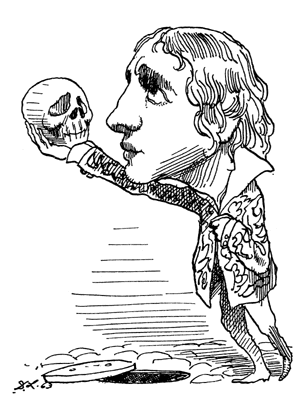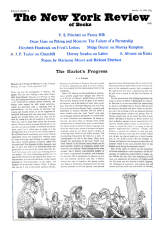A Man’s life of any worth is a continual allegory—and very few eyes can see the Mystery of his life—a life like the scriptures, figurative—Lord Byron cuts a figure—but he is not figurative—Shakespeare led a life of Allegory; his works are the comments on it.
Compared with Keats himself, Shakespeare was lucky. Since we know so little of his life, we are forced to stick to his work. And that, mercifully, is enough to make all the diaries and laundry bills in the world irrelevant. Not so with Keats: his biography is insistent, inescapable. After all, he himself contributed so much towards it in his voluminous letters. And what he left out was filled in by the memoirs of his friends, their bickering and gossip, which raise a dust that almost chokes the poems.
For his life was, in pure form, an allegory of the Romantic poet. Cover his face: mine eyes dazzle: he died young. Had consumption not got him, the reviewers been kinder, and he and Fanny settled improbably into domesticity, the lure of his work would, I think, be much less—even if he had fulfilled his own most stringent ambitions. As it is, his life, or rather his death, somehow completes his poetry. For in terms of mere bulk, there is not all that much there.
His Endymion, as he himself well saw, is a failure, and his Hyperion, fine things as it contains, is not a success. But in shorter things, where the matured power of moral interpretation, and the high architectonics which go with complete poetic development, are not required, he is perfect.
However much we would qualify Matthew Arnold’s judgment, it remains more or less true. Yet that in itself makes Keats very much to the modern taste. Nobody writes long poems any more, and scarcely anyone reads them, unless forced. Indeed, in nearly every way Keats is the most modern of the Romantics: as Eliot once urged, he assimilated the lesson of Shakespeare’s use of language in a wholly original way; he commands a thickness of metaphor and even occasional tricks of synaesthesia which predate the Symbolists; he has a steady ambivalence to death and the senses which goes well beyond the pleasure principle. Above all, he is one of us socially: not quite a gentleman, not quite properly educated, and continually willing to risk his social poise for his convictions; “I always,” he wrote, “made an awkward bow.” Add to all that his sharp critical insights into his fellow Romantics, his belief in the impersonality of great art, his unRomantic vigor and toughness with himself, and he seems a long way from the oversensitive darling of the senses, “snuffed out by an article” and then immortalized in Victorian myth and Severn’s posthumous sketches. “There is,” said his friend Woodhouse, “a great deal of reality about all that Keats writes.”
The factual reality and the myth of Keats’s life are investigated again by his two new biographers, Walter Jackson Bate and Aileen Ward. Professor Bates massive record will, I imagine, be final until the scholars dig up substantially new material—if any remains to be dug. He meticulously goes through every provable detail of Keats’s life: his day-to-day activities, journeys, meetings, dinner parties; the people he knew, the books he read; his dealings with his publishers and with the literary tradition; the development of his meters, his ideas and his finances (Abbey, his guardian, turns out to be the villain of the book, embezzling the legacies of the Keats children). Every source is judged for its reliability, every rumor weighed, and few not found wanting. The result is not only a monumental scrupulousness, at times more monumental than readable, but also a fine scholarly detachment. For all the amassed detail, Professor Bate never pries: he has no theory to pin on his subject; as best he can, he lets the man speak for himself.
Professor Ward is not quite like that. Like Bate, she gives a fairly detailed chronology, but she is far less insistent on facts. She uses even the chancier rumors, such as W. M. Rossetti’s theory of Keats’s syphilis, and weaves from hints elaborate and sometimes novelettish arabesques:
As for Fanny, the nightmare of the summer was over. She was now simply and truly herself to him again, his young love, his beauty, his own, no longer a figure of bale.
The gush sorts oddly with the careful research which Professor Ward has obviously put into the book. Still, exactitude is not primarily her business. Her real interest is in the psychology of genius. With Keats, this means his relationship to his lively, seductive mother who, like Hamlet’s, remarried too soon after his father’s death, abandoned her children, and returned only to die; the question then is how this conflict worked itself out in the psycho-symbolic patterns of his verse and in his behavior. Professor Ward follows this line more or less convincingly, though without going very deep. Oddly enough, she is more incisive about Keats’s first poem, the vapid “Imitation of Spenser,” than about those later gifts to the amateur psychoanalyst, like “La Belle Dame Sans Merci” and the “Ode to Melancholy.”
Advertisement
Yet despite their differences, both biographers are concerned with what is, fundamentally, the sheer improbability of Keats’s poetic career. He was not, like Rimbaud, a prodigy from the start. He was almost nineteen before he wrote his first poem, and for some time after that his development was slow, his talent uncertain. He was, as Professor Bate insists, “surprisingly, refreshingly remote from precocity.” Yet the whole progress, from the stiff beginning, through the literary intoxication and Leigh Hunt-inspired affectations of the first volume, the strain of Endymion (in which he was, said Byron, “viciously soliciting his own imagination”), to the more assured romances, and then to the final burst of great poetry, all this occupies a span of only three years. Keats is the supreme example of creative vitality and concentration. “The Creature has a purpose and his eyes are bright with it.”
Yet this energy is only a necessary preliminary to the great work. His mature verse may depend upon this fullness of life, but it doesn’t really start until the vitality was brought up short by the fact of death. The cycle of his poetic apprenticeship begins and ends with a death: that of his mother turned him to literature—his almost obsessional reading at school dates from then; that of his brother made him a major poet—he began Hyperion while Tom was dying, and in the twelve months which followed produced all his most important poems. Why Tom’s death should have triggered such an incredible burst of creativity is, of course, impossible to say. No doubt the shock, the sense of loss, and the memories which were stirred up of his mother’s and father’s deaths are all part of the process. But what seems to have mattered most was the contrast to his own vital energy; that is, the impersonality of death, the need to acknowledge that this thing happens despite all the care and love and passionate denial in the world. Critically, Keats had come to understand this when he first outlined his theory of negative capability. For that involves something more than a literary insight into the impersonality of great art. It also implies an essential step in psychological maturity: the acknowledgement of the independence of life outside oneself, of the fact that Iago and Cordelia exist in their own right, despite oneself. The stage beyond that is the more difficult acknowledgement of the fact that they can equally cease to exist, despite oneself.
William Empson once remarked that the line No, no; go not to Lethe, neither twist “tells you that somebody, or some force in the poet’s mind, must have wanted to go to Lethe very much, if it took four negatives in the first line to stop them.” Yet that passive, feminine swoon into “easeful death” is only one element in Keats’s more complex effort to assimilate death into creative power, to make it, that is, part of his most intensely felt life. But that is precisely what he seems to have been doing when he rewrote Hyperion. The epic proper can only begin after the poet has undergone a kind of death:
Slow, heavy, deadly was my pace: the cold
Grew stifling, suffocating at the heart;
And when I clasp’d my hands I felt them not.
One minute before death my ic’d foot touch’d
The lowest stair; and, as it touch’d, life seem’d
To pour in at the toes…. “Holy Power,”
Cried I, approaching near the horn- ed shrine,
“What am I that should so be saved from death?” …
Then said the veiled shadow: “Thou last felt
What ’tis to die and live again before
Thy fated hour. That thou hast power to do so
Is thy own safety; thou hast doted on
Thy doom.” “High Prophetess,” said I, “purge off,
Benign, if so it please thee, my mind’s film.”
“None can usurp this height,” re- turned that shade.
“But those to whom the miseries of the world
Are misery, and will not let them rest.
All else who find a haven in the world
Where they may thoughtless sleep away their days,
If by a chance into this fane they come,
Rot on the pavement where thou rot- ted’st half.”
What is in question here is neither suffering nor misery; it is, rather, the ability to understand what death means, to die, as it were, creatively, to transform the negative into a capacity.
Advertisement
One of the nastier paradoxes of art is that, despite all the effort involved, it is not essentially therapeutic. Instead of summing up and so disposing of past experience, it more often seems to provide a rough sketch for what is to come. The poet in writing brings to the surface the conflicts which are nagging him and then finds himself acting them out. So though Keats’s letters may have foreshadowed his poetry, his poetry, in turn, foreshadowed his life. Having got to the rare stage of being able to use his understanding of death for creative ends, he then found himself dying. Revisiting the house in Well Walk, where he had lived with his brothers, Keats told Hunt that he was “dying from a broken heart.” I think he was lamenting more than the deprivation and ruin of his own life—his whole family either dead or inaccessible, and marriage with Fanny Brawne no longer possible—he was also lamenting his own death as a poet. For he wrote nothing more. There followed only what he called his “posthumous life” in Rome, and his own horrified attendance at his second death. Yet “That which is creative must create itself.” Keats understood his death all too clearly, and he understood the terrible wastage it involved. What he could not have foreseen is that from these last pointless months the whole legend of Romantic genius should have been born—cold comfort, perhaps, but in the end sustaining.
This Issue
October 31, 1963




